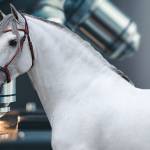Tracking Sperm Motility in Stallions by Measuring a Specific Protein

Progressive sperm motility plays an invaluable role in assessing sperm quality. In lieu of observing motility directly via microscopy, new data show that measuring a specific protein in semen samples can help identify usable frozen or thawed stallion semen.*
The protein proAKAP4 is a precursor to AKAP4, an important protein found in the flagellum, or tail, a structure of every sperm cell that drives forward motion. Previous studies show that proAKAP4 levels reflect the flagellum’s ability to remain “active and functional” up to the site of fertilization.
“Based on those studies, proAKAP4 appears to be a good biomarker of semen quality as this protein correlates well with both total and progressive motility,” explained Catherine Whitehouse, M.S., a nutrition advisor for Kentucky Equine Research.
To further evaluate the relationship between proAKAP4 in stallion semen samples, 48 ejaculates were collected from 13 stallions. Motility descriptors were obtained using traditional methods and proAKAP4 concentrations in those ejaculates were measured using a commercial test kit.
The ejaculates were divided into two groups based on proAKAP4 levels. In these measurements, the abbreviation “spz” stands for spermatozoa. Twenty-three samples had low proAKAP4 levels (5-35 ng/10M spz), and the remaining 25 samples had high proAKAP4 levels (40-82 ng/10M spz). The mean was 37 ng/10M spz.
Semen samples with proAKAP4 greater than 37 ng/10M spz were therefore considered to have very good motility, whereas those with levels less than 37 ng/10M spz, and <15 ng/10M spz in particular, were considered to have poor motility.
The results also showed that samples with lower proAKAP4 levels were slower than samples with higher amounts of proAKAP4.
In conclusion, the research team stated that higher proAKAP4 concentrations are associated with better motion parameters in semen. This test appears to be a valuable complement to current methods of evaluating sperm motility.
One way to support motility nutritionally is through the use of omega-3 fatty acid supplements.
“Omega-3 fatty acids are key components of sperm cell membranes that play important roles in structure, flexibility, and movement. Supplementing with EO-3 may be particularly effective for stallions on high-fat diets or diets that have large amounts of omega-6 fatty acids. EO-3 supplies a direct source of EPA and DHA in the diet and balances the omega-3 to omega-6 ratio.
*Dordas-Perpinyà, M., I. Yanez-Ortiz, N. Sergeant, V. Mevel, J.-F. Bruyas, J. Catalan, M. Delehedde, L. Briand-Amirat, and J. Miro. 2022. ProAKAP4 concentration is related to sperm motility and motile sperm subpopulations in frozen-thawed horse semen. Animals (Basel) 12(23):3417.








